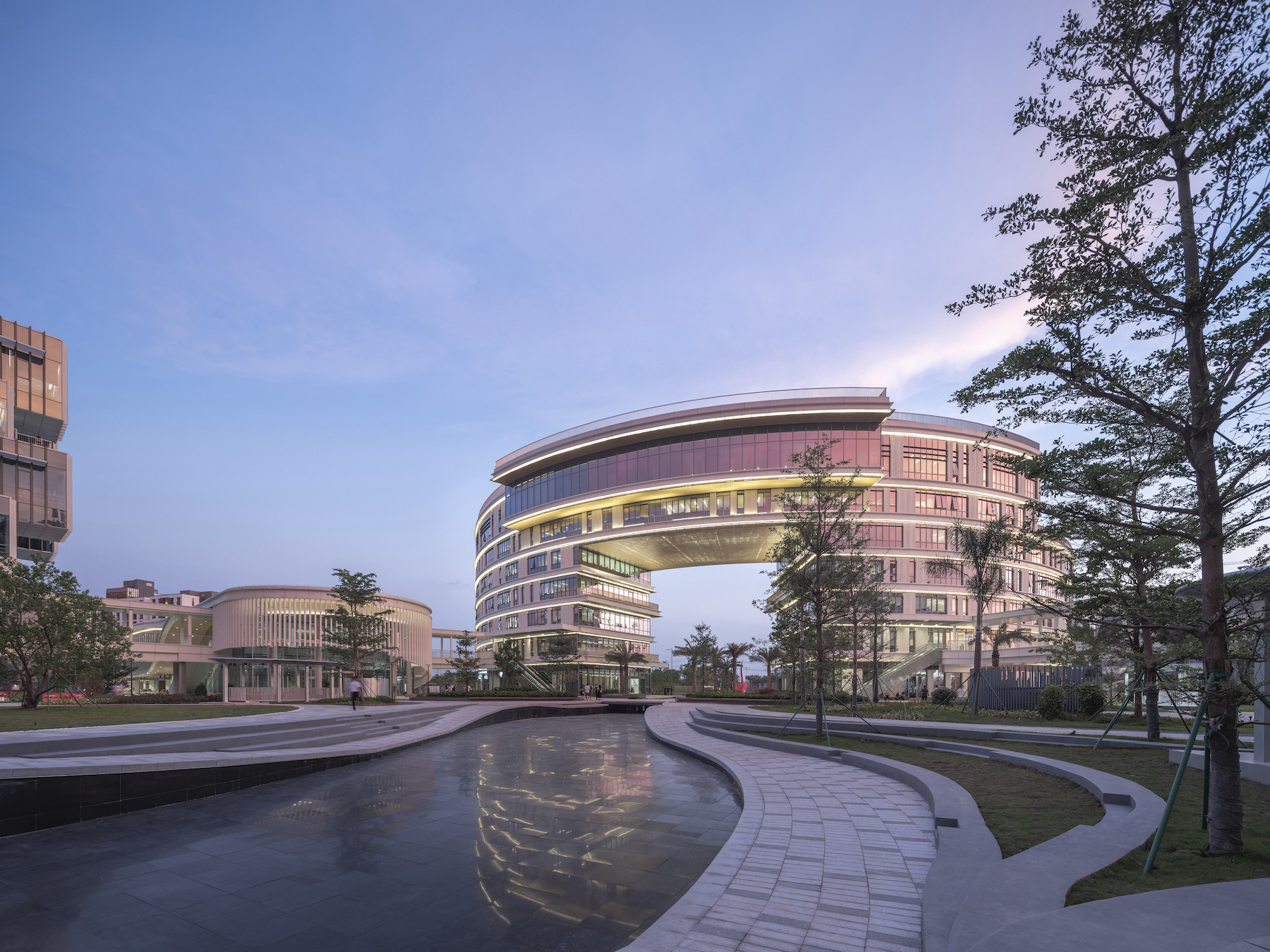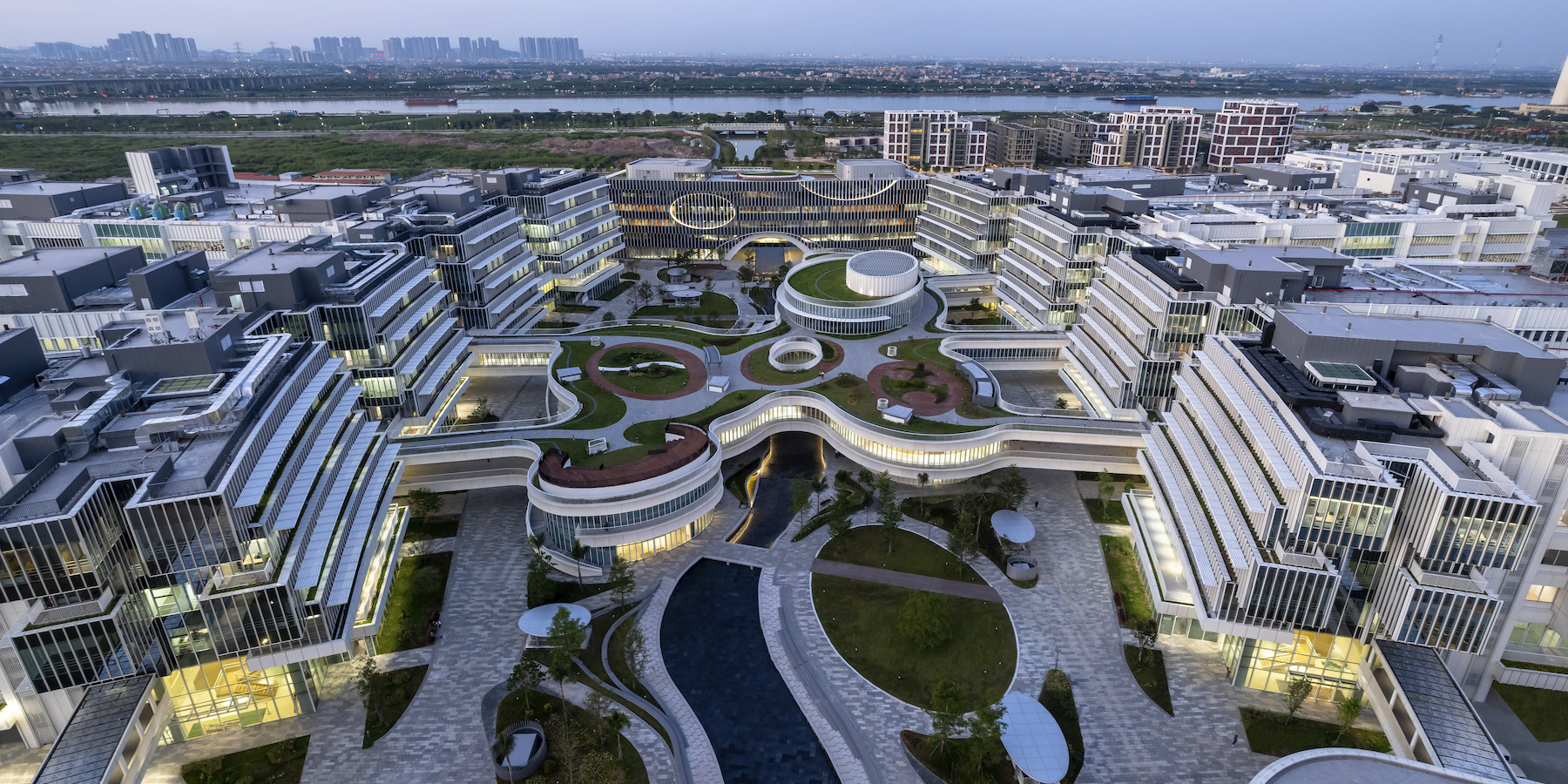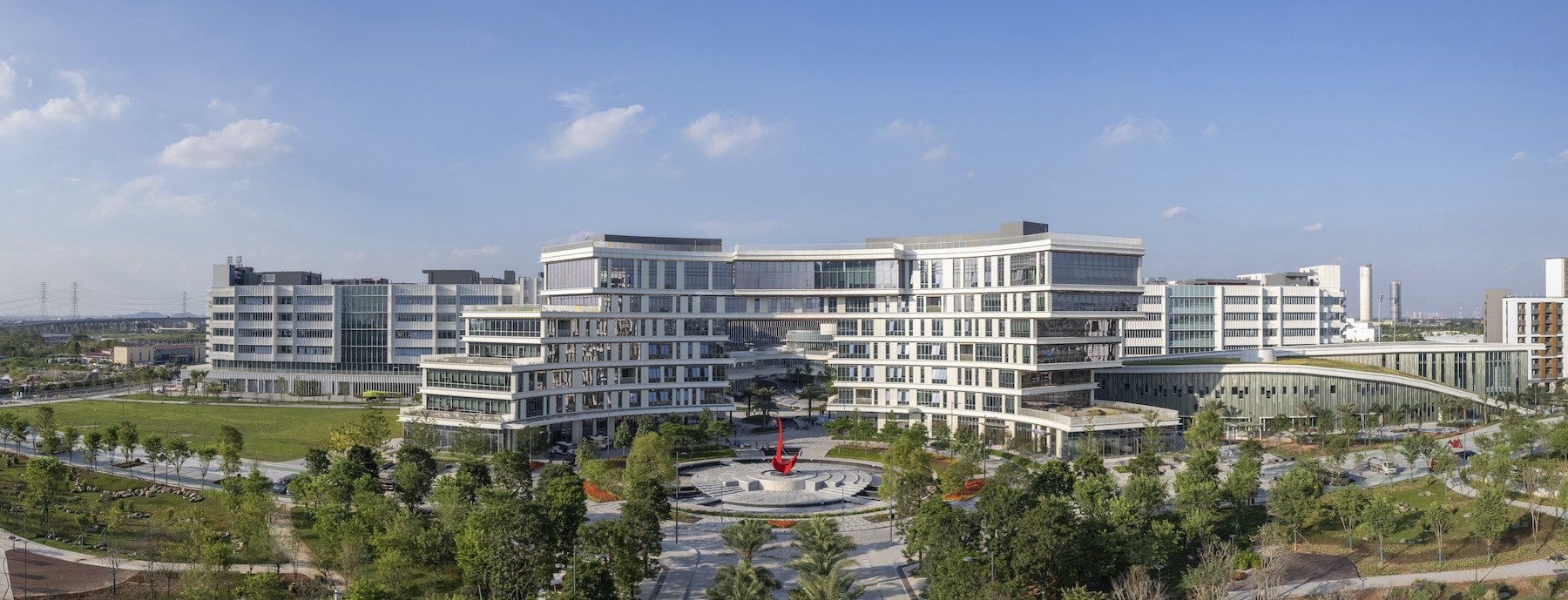In early September, the Hong Kong University of Science and Technology (HKUST) officially opened its new, KPF-designed campus in Nansha, Guangzhou (GZ). The carbon-neutral-ready campus was planned, designed, and built in three years’ time, with a project team comprising over 70 architects and planners across KPF offices in New York, Shanghai, Hong Kong, and Singapore.
The project’s first phase includes nearly 6 million square feet (about 550,000 square meters) for over 4,000 graduate students and 400 faculty members. It provides research facilities for subjects such as robotics and autonomous systems, smart manufacturing and transportation, microelectronics, and atmosphere and ocean systems.
Rather than following a traditional academic structure based on schools and disciplines, HKUST(GZ) centers around a project-based learning model that encourages multi-disciplinary interactions. The campus features eight research and lab buildings, connected by shaded arcades, and a full range of teaching spaces, including seminar classrooms, labs, large lecture halls, maker spaces, and collaborative workspaces.
“Landscape and building spaces come together to create an atmosphere where scientists will be energized and inspired to innovate,” James von Klemperer, KPF president, said in a statement.
From day one, HKUST(GZ) achieves a 54 percent reduction of carbon emissions, with a goal of reaching carbon neutrality before 2060. The plan’s environmental and resiliency measures have been designed for Guangzhou’s hot, humid climate and the rapidly urbanizing area’s flooding, seismic, and climate change risks.
When complete, the campus will accommodate more than 10,000 students and faculty. And it will integrate teaching and learning facilities with housing, neighborhood and campus retail, student life programs, administration, hotel, office and incubator spaces, and athletics facilities.
The HKUST(GZ) campus adds to KPF’s portfolio of research, innovation, and academic facilities around the world, including the CUNY Advanced Science Research Centers in New York City, the University of Michigan’s Detroit Center for Innovation, and NYU’s new Qiantan campus in Shanghai.
On the Building Team:
Owner: Hong Kong University of Science and Technology
Design architect: Kohn Pedersen Fox (KPF)
Architect of record: SCAD (Architectural Design & Research Institute of South China University of Technology Co.)
MEP engineer: ARUP
Structural engineer: ARUP
Landscape design: James Corner Field Operations
General contractor/construction manager: central hub: China Railway First Group Co. and China Railway Guangzhou Engineering Group Co.; other areas:
Canton One Construction Group Co. and Guangzhou Construction Engineering Co.


Related Stories
| Jan 21, 2011
Nothing dinky about these residences for Golden Gophers
The Sydney Hall Student Apartments combines 125 student residences with 15,000 sf of retail space in the University of Minnesota’s historic Dinkytown neighborhood, in Minneapolis.
| Jan 21, 2011
Virginia community college completes LEED Silver science building
The new 60,000-sf science building at John Tyler Community College in Midlothian, Va., just earned LEED Silver, the first facility in the Commonwealth’s community college system to earn this recognition. The facility, designed by Burt Hill with Gilbane Building Co. as construction manager, houses an entire floor of laboratory classrooms, plus a new library, student lounge, and bookstore.
| Jan 20, 2011
Community college to prepare next-gen Homeland Security personnel
The College of DuPage, Glen Ellyn, Ill., began work on the Homeland Security Education Center, which will prepare future emergency personnel to tackle terrorist attacks and disasters. The $25 million, 61,100-sf building’s centerpiece will be an immersive interior street lab for urban response simulations.
| Jan 19, 2011
Biomedical research center in Texas to foster scientific collaboration
The new Health and Biomedical Sciences Center at the University of Houston will facilitate interaction between scientists in a 167,000-sf, six-story research facility. The center will bring together researchers from many of the school’s departments to collaborate on interdisciplinary projects. The facility also will feature an ambulatory surgery center for the College of Optometry, the first of its kind for an optometry school. Boston-based firms Shepley Bulfinch and Bailey Architects designed the project.
| Dec 28, 2010
Project of the Week: Community college for next-gen Homeland Security personnel
The College of DuPage, Glen Ellyn, Ill., began work on the Homeland Security Education Center, which will prepare future emergency personnel to tackle terrorist attacks and disasters. The $25 million, 61,100-sf building’s centerpiece will be an immersive interior street lab for urban response simulations.
| Dec 17, 2010
Sam Houston State arts programs expand into new performance center
Theater, music, and dance programs at Sam Houston State University have a new venue in the 101,945-sf, $38.5 million James and Nancy Gaertner Performing Arts Center. WHR Architects, Houston, designed the new center to connect two existing buildings at the Huntsville, Texas, campus.
| Dec 17, 2010
New engineering building goes for net-zero energy
A new $90 million, 250,000-sf classroom and laboratory facility with a 450-seat auditorium for the College of Electrical and Computer Engineering at the University of Illinois at Urbana/Champaign is aiming for LEED Platinum.
| Dec 17, 2010
How to Win More University Projects
University architects representing four prominent institutions of higher learning tell how your firm can get the inside track on major projects.
| Nov 23, 2010
The George W. Bush Presidential Center, which will house the former president’s library
The George W. Bush Presidential Center, which will house the former president’s library and museum, plus the Bush Institute, is aiming for LEED Platinum. The 226,565-sf center, located at Southern Methodist University, in Dallas, was designed by architect Robert A.M. Stern and landscape architect Michael Van Valkenburgh.
| Nov 9, 2010
Just how green is that college campus?
The College Sustainability Report Card 2011 evaluated colleges and universities in the U.S. and Canada with the 300 largest endowments—plus 22 others that asked to be included in the GreenReportCard.org study—on nine categories, including climate change, energy use, green building, and investment priorities. More than half (56%) earned a B or better, but 6% got a D. Can you guess which is the greenest of these: UC San Diego, Dickinson College, University of Calgary, and Dartmouth? Hint: The Red Devil has turned green.
















